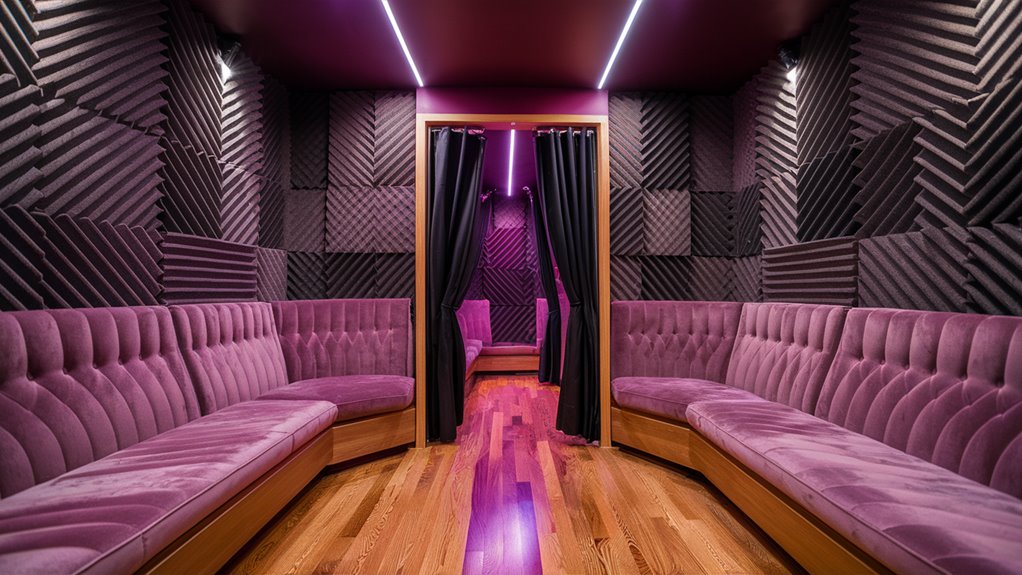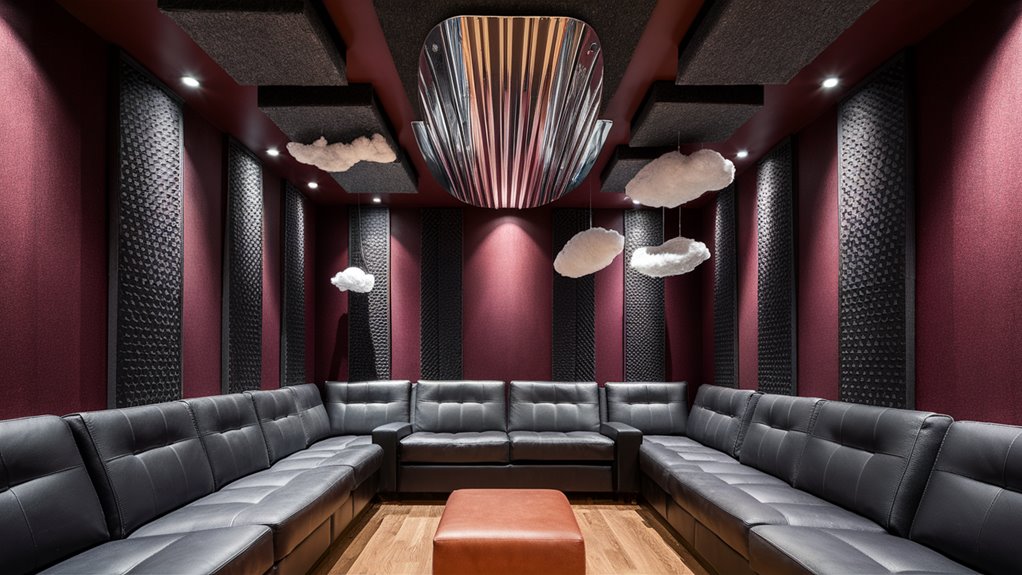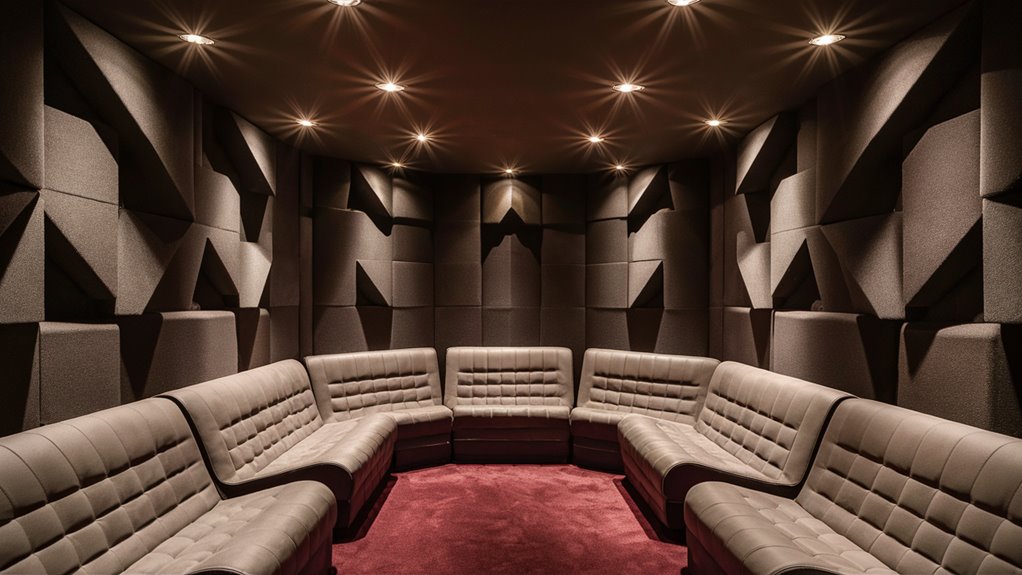
Karaoke Room Size: How to Make Your Room Sound Best

Key Space Needs
Set up your top karaoke room by picking the right size. Aim for 15-20 square feet per person, starting with 80-120 square feet for 4-6 folks. A rectangular area with a 1:1.6 width-to-height size is best for sound 먹튀검증업체
Room Sizes and Shapes
Get great sound using the golden ratio of 3:4:5 (15’L x 12’W x 9’H). Keep ceilings at least 8 feet high in small rooms to help with sound. This set-up cuts out bad echoes.
How to Set Up Sound Panels
Put sound panels right to fix sound. Cover 15-25% of the walls with panels, focusing on key echo spots. Aim for a RT60 time of 0.7-1.2 seconds to control echoes well. Sound-blocking stuff should go all over the walls and ceiling.
Setting Up Speakers and Singing Spaces
Place speakers at 60-degree angles from where you sit to hear well. Keep singers 3 feet away from walls to stop feedback and let sound out. This setting clears up voices and cuts down on echoes.
Good Karaoke Room Sizes Guide
Basic Space Needs
Picking room sizes for karaoke needs good number work based on how many will sing and gear set-up. The basic need is 15-20 square feet per person for top sound and comfort. Groups of 4-6 need at least 80-120 square feet for the best singing time karaoke machine or full system
Ceiling Height and Room Shape
Great sound design uses a 1:1.6 width-to-height size for rectangle rooms. 8-foot ceilings are good for small rooms, while bigger places need 9-10 foot ceilings to handle sound well.
Gear Space Needs
Important gear sizes:
- Karaoke set: 3×3 feet
- Sitting spots: 4×6 feet
- Speakers: 3×4 feet
- Screen space: At least 8-foot wide wall for 50-inch screens
Making Rooms Sound Great
Top room sound follows the 3:4:5 ratio:
- Length: 15 feet
- Width: 12 feet
- Height: 9 feet
This shape makes sure the sound is great and keeps echoes low, making the best karaoke spot.
Ways to Keep Sound in Rooms Right
Picking Where to Put Sound Panels
Catching sound right needs exact numbers, with the best panel spot covering 15-25% of all wall area. Know your room’s full wall size before putting sound panels to catch big noises just right.
Key Echo Spots and Where to Put Panels
Main echo spots are key areas where sound first bounces back at listeners. Use the mirror trick: put a mirror on walls while sitting down – spots where speakers show are where to put panels.
More on Grabbing Sound and Using Materials
Room echo time (RT60) should be 0.7-1.2 seconds for great sound. Use materials that grab sound well:
- Thick curtains: 0.5-0.7
- Soft foam: 0.5-0.95
- Corner traps: 0.8-1.0
Use different materials to control all sound types. Put corner traps in room edges to handle low sounds. This mix makes sure sounds are caught well all around.
Best Ways to Set Rooms for Sound

Where to Put Speakers and Managing Sound Waves
Picking where to put speakers is key for top audio quality. Set main speakers at a 60-degree angle from where you sit, making a triangle with 8-10 feet on each side. This layout gives the most even sound and good sound across all tones.
Bass and Gear Spots
Put the bass speaker on solid walls, but not corners to stop too much bass. Best spots are 1/3 down the room for even low sounds. The gear spot works best in the middle of the room, 38% from the back for the best sound check.
Space for Singing
Checking the voice needs about 3 feet of free space around singers to cut down on early echoes. Set floor speakers at 45 degrees, right at singers from 4-6 feet away. Keep a 6-foot gap between singers and the crowd to stop sound problems and keep sound clear. This setup makes sure the sound is boosted right while keeping it clear.
Tuning Room Sound
Create sound zones by smartly putting panels and diffusers to handle echo. Room fixes should focus on main echo spots and keep sound even all over. Think about ceiling height and room sizes when setting speakers for the best sound.
Keeping Sound Bounces in Check in Rooms
Know Main Echo Spots
Managing sound bounces needs tight control over both first and later echoes in any singing space. The key mirror trick spots key echo points – putting mirrors on walls to see where speakers show from where you sing. These spots need quick sound fixes.
Pro Sound Panel Uses
Panels set at 2-4 inches thick at first echo spots can cut down on 80% of bad echoes. Greatest coverage needs covering 15-25% of all wall space for strong sound catching. Corner traps put in room corners at at least 4-inch depth handle deep sound build-up.
Checking Room Sound
Testing rooms makes sure reflection control is spot on with sound meter tests and RT60 math. Small singing spots under 200 square feet should aim for an RT60 time between 0.2 and 0.4 seconds. Sound tests at different room spots check even sound spread and spot still bad echoes needing more fixes.
Vent and Noise Set-Up for Karaoke Rooms
Best Vent Specs
Pro karaoke room vents need well-set HVAC systems with noise levels between NC-25 and NC-30. This setup makes sure of good air flow while keeping sound right. A well-made vent design must get 8-10 air changes each hour for most karaoke spots, mixing air quality with sound safety.
Top Noise Fix Plans
Quiet vents with inner sound linings cut HVAC noise by 15-20 decibels. Air come-backs should be set at least 8 feet from main singing spots to stop unwanted sound mess-ups. Soft vent links cut down shaking, while changing fan speeds fit air flow needs based on how full the room is.
Pro Sound Control Moves
Vent mufflers with at least 25 dB cuts in mid-tones make sure of top sound performance. Air spreaders should keep air speed under 300 feet per minute to stop loud air sounds. These full vent setups make the best mix of sound care and air quality, giving top spots for karaoke singing.